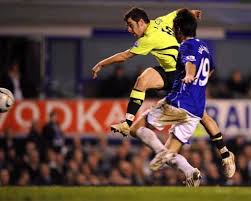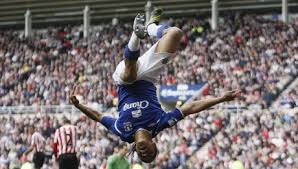
 |  |  |

English Premier League
England
The Barclays English Premier League (EPL), considered as the best in the world.
Sunderland vs Everton FC
Official name Sunderland AFC
City Sunderland
Founded 1879
Club colors Red-White vertical striped / Black / Black
vs.
0 - 0
Everton FC
Official name Everton FC
City Liverpool
Founded 1878
Club colors Blue / White / White
Match scheduled:
Date: 26-12-2009
Time:15:00 until 17:00
Week 19 / Round 19 :: Barclays Premier League 2009/2010 :: Maybe also on Soccer and other Sop channels!

Sunderland moved to Newcastle Road in 1886. By 1898, the ground reached a capacity of 15,000 after renovations, and its rent had risen to £100 (£8 thousand today) a year.[14][81] Near the turn of the century, Sunderland needed a bigger stadium. They returned to Roker and set up home in Roker Park. It was opened on 10 September 1898, and the home team played a match the same day against Liverpool,[82] which they won. The stadium's capacity increased to 50,000 after redevelopment with architect Archibald Leitch in 1913. Sunderland were nearly bankrupted by the cost of renovating the Main Stand, and Roker Park was put up for sale but no further action was taken. On 8 March 1933, an overcrowded Roker Park recorded the highest ever attendance at a Sunderland match, 75,118 against Derby County in a FA Cup sixth round replay.[83] Roker Park suffered a bombing in 1943, in which once corner of the stadium was destroyed. A special constable was killed whilst patrolling the stadium. By the 1990s, the stadium was no longer large enough, and had no room for possible expansion.[84] In January 1990, the Taylor Report was released after overcrowding at the Hillsborough Stadium resulted in 96 deaths, an incident known as the Hillsborough Disaster.[85] The report recommended that all major stadiums must be converted to an all-seater design.[86] As a result, Roker Park's capacity was reduced. It was demolished in 1997 and a housing estate built in its place.[82]

In 1997, Sunderland moved to their present ground, Stadium of Light in Monkwearmouth, which was opened by Prince Andrew, Duke of York. Built with an original capacity of 42,000, it hosted its first game against Dutch team Ajax.[87] The stadium bears the same name as the Portuguese club Benfica's ground Estádio da Luz, albeit in a different language. Renovations in 2000 saw the capacity rise to 49,000. A Davy lamp monument stands outside the stadium, as a reminder of the Monkwearmouth Colliery pit the stadium was built on.[88] Future reconstruction would allow the stadium's capacity to reach 66,000.[89]
At the end of the 1937–38 season, Everton secretary Theo Kelly, who later became the club's first manager, wanted to design a club necktie. It was agreed that the colour be blue and Kelly was given the task of designing a crest to be featured on the necktie. Kelly worked on it for four months, until deciding on a reproduction of Prince Rupert's Tower, which stands in the heart of the Everton district.[26]
The Tower has been inextricably linked with the Everton area since its construction in 1787. It was originally used as a bridewell to incarcerate mainly drunks and minor criminals, and it still stands today on Everton Brow in Netherfield Road. The tower was accompanied by two laurel wreaths on either side and, according to the College of Arms in London, Kelly chose to include the laurels as they were the sign of winners. The crest was accompanied by the club motto, "Nil Satis Nisi Optimum", meaning "Nothing but the best is good enough".
The ties were first worn by Kelly and the Everton chairman, Mr. E. Green, on the first day of the 1938–39 season.[26]
The club rarely incorporated a badge of any description on its shirts. An interwoven "EFC" design was adopted between 1922 and 1930 before the club reverted to plain royal blue shirts, until 1973 when bold "EFC" lettering was added. The crest designed by Kelly was first used on the team's shirts in 1980 and has remained there ever since, undergoing gradual change to become the version used today.
At the end of the 1937–38 season, Everton secretary Theo Kelly, who later became the club's first manager, wanted to design a club necktie. It was agreed that the colour be blue and Kelly was given the task of designing a crest to be featured on the necktie. Kelly worked on it for four months, until deciding on a reproduction of Prince Rupert's Tower, which stands in the heart of the Everton district.[26]
The Tower has been inextricably linked with the Everton area since its construction in 1787. It was originally used as a bridewell to incarcerate mainly drunks and minor criminals, and it still stands today on Everton Brow in Netherfield Road. The tower was accompanied by two laurel wreaths on either side and, according to the College of Arms in London, Kelly chose to include the laurels as they were the sign of winners. The crest was accompanied by the club motto, "Nil Satis Nisi Optimum", meaning "Nothing but the best is good enough".
The ties were first worn by Kelly and the Everton chairman, Mr. E. Green, on the first day of the 1938–39 season.[26]
The club rarely incorporated a badge of any description on its shirts. An interwoven "EFC" design was adopted between 1922 and 1930 before the club reverted to plain royal blue shirts, until 1973 when bold "EFC" lettering was added. The crest designed by Kelly was first used on the team's shirts in 1980 and has remained there ever since, undergoing gradual change to become the version used today.
Everton originally played in the southeast corner of Stanley Park, which is the site for the new Liverpool F.C. stadium, with the first official match taking place in 1879. In 1882, a man named J. Cruitt donated land at Priory Road which became the club's home before they moved to Anfield, which was Everton's home until 1892.[31] At this time, a dispute of how the club was to be owned and run emerged with Anfield's owner and Everton's chairman, John Houlding. A dispute between Houlding and the club's committee over how the club should be run, led to Houlding attempting to gain full control of the club by registering the company, "Everton F.C. and Athletic Grounds Ltd".[citation needed] In response, Everton left Anfield for a new ground, Goodison Park, where the club have played ever since. Houlding attempted to take over Everton's name, colours, fixtures and league position, but was denied by The Football Association.[citation needed] Instead, Houlding formed a new club, Liverpool F.C..
Ever since those events, a fierce rivalry has existed between Everton and Liverpool, albeit one that is generally perceived as more respectful than many other derbies in English football. This was illustrated by a chain of red and blue scarves that were linked between the gates of both grounds across Stanley Park as a tribute to the Liverpool fans killed in the Hillsborough disaster.[32]
Goodison Park, the first major football stadium to be built in England, was opened in 1892.[33] Goodison Park has staged more top-flight football games than any other ground in the United Kingdom and was the only English club ground to host a semi-final at the 1966 FIFA World Cup. It was also the first English ground to have undersoil heating, the first to have two tiers on all sides.
 |  |  |







